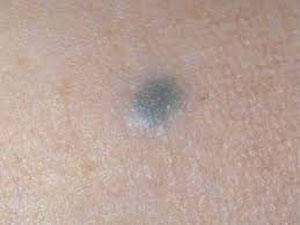Blue nevus melanoma is a rare variant of malignant melanoma that develops over a pre-existing blue nevus. This particular type of melanoma was first described by Allen and Spitz and occurs mainly on the scalp, although cases have been reported on the arms and other parts of the body. The condition is more common in men, with a peak incidence at age 45.

Blue nevi are benign skin lesions, which have a blue or blue-grey coloration due to the deep localization in the dermis of melanocyte cells, which produce pigment. When melanoma develops over a blue nevus, you may notice a change in size, color, or an ulceration, and the lesion can range from 3 to 15 cm in size.
Histologically, a blue nevus substrate is present at the base of the melanoma, and a malignant component is seen at the periphery. A dense inflammatory infiltrate is frequently present at the base of the lesion. Cancer cells may appear spindle-shaped and epithelioid, clustered in bundles or nodules which then fuse. Giant cells are also sometimes noted. Mitotic figures are numerous and there may be areas of necrosis.
This type of melanoma behaves aggressively, metastasizes frequently, and can be especially difficult to diagnose, because the presence of the underlying blue nevus can mask some of the typical features of melanoma. Diagnosis and treatment follow the general guidelines for cutaneous melanoma, with biopsy of the lesion in case of suspected melanoma and, if the diagnosis is confirmed, surgical removal of the tumor.